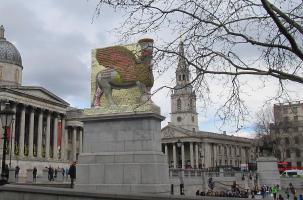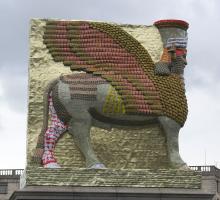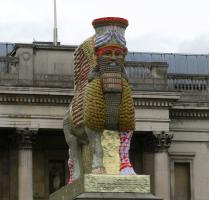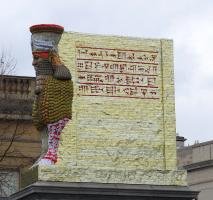Trafalgar Square Fourth Plinth statue of Assyrian winged bull, by Michael Rakowitz – sculpture of the month for April
The sculpture of an Assyrian winged bull, with characteristic bearded man’s head, now on the fourth plinth of Trafalgar Square is the best piece of sculpture which has been put there. Michael Rakowitz in the sculptor.
Trafalgar Square, Fourth Plinth Sculpture by Michael Rakowitz.
This website does not generally cover modern sculpture, but I wanted to make an exception for this fine piece by Michael Rakowitz, so much better than the other things which have been put on the fourth plinth in Trafalgar Square. It is part of a project by the artist recreating a series of works in Iraq and Syria artefacts destroyed by Isis, and entitled ‘The Invisible Enemy Should Not Exist’.
From the left hand side, the figure is familiar – similar beasts, on a similar massive scale, can be seen in the British Museum: the coloration is the surprise, and works well. Normally, such beasts have more than four legs in total: typically a pair will form the supports for a gate, and being designed to be seen from the side and from the front, we see five legs in total; the other side would be hidden. So the Fourth Plinth one is missing a view of the further-away front leg when seen from the left hand side. From the front, we see a pair of legs, there are no legs on the other side (normally such a beast would be against a wall on the outside), thus just four legs on this example. Instead, we have a plain wall, golden coloured, with text upon it written in the spiky wedged cuneiform text of the Assyrians.
Fourth Plinth Assyrian winged bull by Rakowitz, different views.
We are used to seeing Assyrian winged bulls (also called Lammasu statues) in plain uncoloured stone, but like ancient Greek statues, they were likely painted too, and the gaudy, bright colours here look well rather than jarring. The grafting of a human and an animal is familiar in ancient art, and Victorian art too – most familiar are the mermaids and mermen, satyrs, which in Victorian times were favoured as grotesques (i.e. where the figure is subsumed into the design), sphinxes, which were greatly popular in England and abroad after the discoveries in Ancient Egypt, centaurs and fauns, though these are far more frequent in painting than sculpture, and angels of course, which became one of the most common of all Victorian sculptural types, though derived from Medieval rather than Classical sculpture. The Assyrian winged lion with human head though, although much engraved in the 19th Century, does not seem to have made it into Victorian sculpture, other than the odd small pendant, or if it has, I have not seen them.
The fusion of person and animal gives certain problems for the artist, notably how to keep some sense of proportion between the two. A larger head than would be appropriate for human shoulders is the answer for both Lamassu and sphinxes, to make the head not appear small for the body, and this is what we see here; the mermaid takes a different approach and aims to have a figure close to human proportions, so that even the tail typically approaches the dimensions of the human legs.
The artist, Michael Rakowitz, an American-Jewish artist of Iraqi descent , was born in New York in 1973, and resides in Chicago. The various works in this series, which he has been making since 2007, so far as I have been able to find them, seem to be relatively small papier mache pieces of no great size, deliberately using not so permanent materials as a conceptual artist’s comment on the destruction of the original ancient artworks. The London piece, like several others, is made from recycled materials, in this case syrup cans – 10,500 of them according to the newspapers. On this much larger scale, an amount of detail is possible which is not the case with the smaller works. Good stuff!



